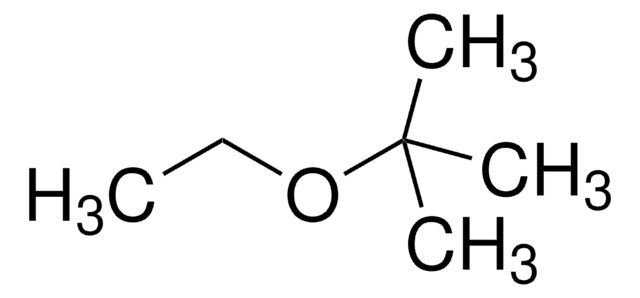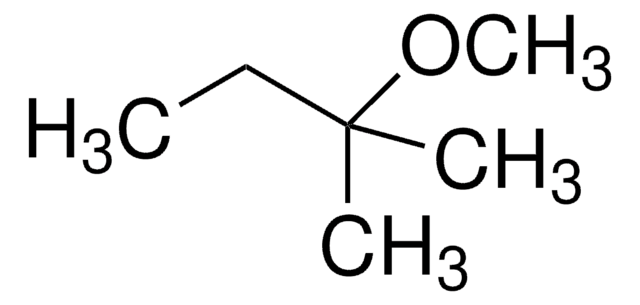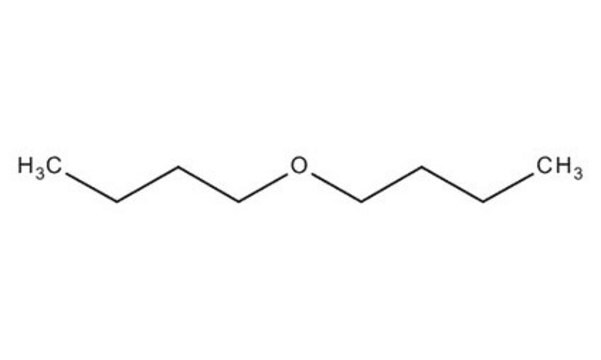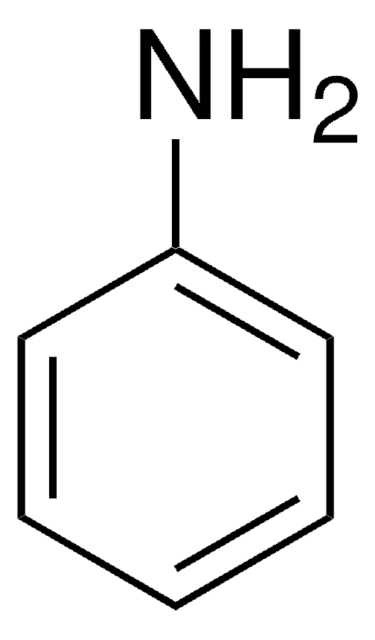8.41873
tert-Butyl ethyl ether
for synthesis
Synonyme(s) :
tert-Butyl ethyl ether
About This Item
Produits recommandés
Pression de vapeur
173 hPa ( 25 °C)
Niveau de qualité
Essai
≥95.0% (GC)
Forme
liquid
Puissance
>2000 mg/kg LD50, oral (Rat)
>2000 mg/kg LD50, skin (Rabbit)
Limite d'explosivité
1.23-7.7 % (v/v)
pb
71 °C/1013 hPa
Pf
-97 °C
Température de transition
flash point -19 °C
Solubilité
12 g/L
Densité
0.74 g/cm3 at 20 °C
Température de stockage
2-30°C
InChI
1S/C6H14O/c1-5-7-6(2,3)4/h5H2,1-4H3
Clé InChI
NUMQCACRALPSHD-UHFFFAOYSA-N
Application
- Quantitative structure-property relationship modeling: tert-Butyl ethyl ether is used in physiologically based kinetic modeling, showcasing its role in quantitative structure-property relationship (QSPR) studies and Monte Carlo simulations, which are crucial for predicting the behavior of chemicals in biological systems (Yamada et al., 2022).
- Automatic monitoring of VOCs: It is utilized in the development of an in-source helical membrane inlet with single photon ionization time-of-flight mass spectrometry, enhancing the automatic monitoring of trace volatile organic compounds in water, significant for environmental monitoring and safety (Li et al., 2019).
- Pharmacokinetic and toxicological research: The ether serves as a subject in the development and application of rat physiologically based pharmacokinetic (PBPK) models to elucidate kidney and liver effects induced by ethyl tert-butyl ether and tert-butanol, offering valuable insights into its safety and physiological impacts (Chiu et al., 2015).
- Environmental monitoring: It is also featured in research focusing on the determination of fuel ethers in water by membrane extraction ion mobility spectrometry, providing an efficient method for environmental monitoring of this compound in aquatic systems (Sillanpää et al., 2013).
- Exposure assessment: Research includes exposure assessment studies of ethyl tert-butyl ether among gas station workers and gasoline tanker truck drivers, emphasizing the importance of occupational safety and health standards in industries using this chemical (Omae et al., 2011).
Remarque sur l'analyse
Density (d 20 °C/ 4 °C): 0.737 - 0.744
Identity (IR): passes test
Mention d'avertissement
Danger
Mentions de danger
Conseils de prudence
Classification des risques
Flam. Liq. 2 - STOT SE 3
Organes cibles
Central nervous system
Code de la classe de stockage
3 - Flammable liquids
Classe de danger pour l'eau (WGK)
WGK 1
Point d'éclair (°F)
-2.2 °F - closed cup
Point d'éclair (°C)
-19 °C - closed cup
Certificats d'analyse (COA)
Recherchez un Certificats d'analyse (COA) en saisissant le numéro de lot du produit. Les numéros de lot figurent sur l'étiquette du produit après les mots "Lot" ou "Batch".
Déjà en possession de ce produit ?
Retrouvez la documentation relative aux produits que vous avez récemment achetés dans la Bibliothèque de documents.
Notre équipe de scientifiques dispose d'une expérience dans tous les secteurs de la recherche, notamment en sciences de la vie, science des matériaux, synthèse chimique, chromatographie, analyse et dans de nombreux autres domaines..
Contacter notre Service technique







